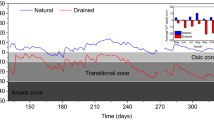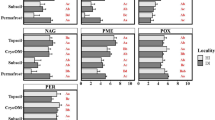Abstract
Mangrove swamps accumulate a significant amount (45–98 %) of organic carbon in sediments; however, there is a knowledge gap in explaining the mechanism behind this. Through the analysis of substrate samples from a red mangrove (Rhizophora mangle) swamp in southwest Florida, USA, this study investigated whether the “enzymic latch”, which suppresses decomposition in northern peatlands, is prevalent in mangrove soils. Laboratory analyses were performed to investigate the four hypotheses of the “enzymic latch”. Results showed that under aerobic conditions mangroves soil samples have significantly higher phenol oxidase activity (two-fold, p < 0.05), but lower phosphatase activity (−33 %, p < 0.05), β-glucosidase activity (−14 %) and glucosaminidase activity (−11 %) compared to anaerobic conditions. Soil samples supplemented with phenol oxidase showed significantly lower phenolic concentration (−8.3 %, p < 0.01), but increased β-glucosidase (+79 %, p < 0.05), xylosidase (+99 %, p < 0.01) and glucosaminidase (+102 %, p < 0.01) activities. Supplementation of lignin-based solution significantly lowered β-glucosidase (−55 %, p < 0.001), sulphatase (−82 %, p < 0.001) and glucosaminidase (−45 %, p < 0.01) activities. Based on these findings, it is concluded that the “enzymic latch” is highly likely to play a key role in suppressing decomposition rates in red mangrove covered areas of mangrove swamps.







Similar content being viewed by others
References
Alongi DM (2002) Present state and future of the world’s mangrove forests. Environ Conserv 29:331–349
Alongi DM, Clough BF, Robertson AI (2005) Nutrient-use efficiency in arid-zone forests of the mangroves Rhizophora stylosa and Avicennia marina. Aquat Bot 82:121–131
Boto KG, Bunt JS (1981) Tidal export of particulate organic matter from a Northern Australian mangrove system. Estuar Coast Shelf Sci 13:247–255
Bouillon S, Moens T, Overmeer I, Koedam N, Dehairs F (2004) Resource utilization patterns of epifauna from mangrove forests with contrasting inputs of local versus imported organic matter. Mar Ecol-Progr Ser 278:77–88
Bouillon S, Connolly RM, Lee SY (2008) Organic matter exchange and cycling in mangrove ecosystems: recent insights from stable isotope studies. J Sea Res 59:44–58
Box JD (1983) Investigation of the Folin-Ciocalteau phenol reagent for the determination of polyphenolic substances in natural waters. Water Res 17:511–525
Brookes PC (1995) The use of microbial parameters in monitoring soil pollution by heavy metals. Biol Fertil Soils 19:269–279
Dinesh R, Shome BR, Shome R, Bandyopadhyay AK (1998) Soil enzymes in the mangroves: activities and their relation to relevant soil properties. Curr Sci 75:510–512
Donato DC, Kauffman JB, Murdiyarso D, Kurnianto S, Stidham M, Kanninen M (2011) Mangroves among the most carbon-rich forests in the tropics. Nat Geosci 4:293–297
Duke NC, Meynecke JO, Dittmann S, Ellison AM, Anger K, Berger U, Cannicci S, Diele K, Ewel KC, Field CD, Koedam N, Lee SY, Marchand C, Nordhaus I, Dahdouh-Guebas F (2007) A world without mangroves? Science 317:41–42
Dunn C, Jones T, Girard A, Freeman C (2014) Methodologies for extracellular enzyme assays from wetland soils. Wetlands 34:9–17
Fenner N, Freeman C (2011) Drought-induced carbon loss in peatlands. Nat Geosci 4:895–900
Fenner N, Freeman C, Reynolds B (2005) Hydrological effects on the diversity of phenolic degrading bacteria in a peatland: implications for carbon cycling. Soil Biol Biochem 37:1277–1287
Florida State University (2015) Climatic data: 1981–2010 normals. Florida Climate Center: The Florida State University. http://climatecenter.fsu.edu/products-services/data/1981-2010-normals/ft-myers. Accessed 12 July 2015
Freeman C, Liska G, Ostle NJ, Jones SE, Lock MA (1995) The use of fluorogenic substrates for measuring enzyme activity in peatlands. Plant Soil 175:147–152
Freeman C, Ostle N, Kang H (2001) An enzymic ‘latch’ on a global carbon store. Nature 409:149
Freeman C, Ostle NJ, Fenner N, Kang H (2004) A regulatory role for phenol oxidase during decomposition in peatlands. Soil Biol Biochem 36:1663–1667
Freeman C, Fenner N, Shirsat AH (2012) Peatland geoengineering: an alternative approach to terrestrial carbon sequestration. Philos Trans R Soc A 370:4404–4421
Frogbrook ZL, Bell J, Bradley RI, Evans C, Lark RM, Reynolds B, Smith P, Towers W (2009) Quantifying terrestrial carbon stocks: examining the spatial variation in two upland areas in the UK and a comparison to mapped estimates of soil carbon. Soil Use Manag 25:320–332
Giri CE, Ochieng L, Tieszen L, Zhu Z, Singh A, Loveland T, Masek J, Duke N (2011) Status and distribution of mangrove forests of the world using earth observation satellite data. Glob Ecol Biogeogr 20:154–159
Holguin G, Vazquez P, Bashan Y (2001) The role of sediment microorganisms in the productivity, conservation, and rehabilitation of mangrove ecosystems: an overview. Biol Fertil Soils 33:265–278
Hoppe HG (1983) Significance of exoenzyme activities in the ecology of brackish water: measurement by means of methylumbelliferyl substrates. Mar Ecol Prog Ser 11:299–308
Kang H, Freeman C (1999) Phosphatase and arylsulphatase activities in wetland soils: annual variation and controlling factors. Soil Biol Biochem 31:449–454
Kang H, Freeman C (2009) Soil enzyme analysis for leaf litter decomposition in global wetlands. Commun Soil Sci Plant Anal 40:3323–3334
Kathiresan K, Saravanakumar K, Anburaj R, Gomathi V, Abirami G, Sahu SK, Anandhan S (2011) Microbial enzyme activity in decomposing leaves of mangroves. Int J Adv Biotechnol Res 2:382–389
Kristensen E, Bouillon S, Dittmar T, Marchand C (2008) Organic carbon dynamics in mangrove ecosystems: a review. Aquat Bot 89:201–219
Luo L, Gu JD (2014) Seasonal variability of extracellular enzymes involved in carbon. Geomicrobiol J 32:68–76
Marois D, Mitsch WJ (2015) Coastal protection from tsunamis and cyclones provided by mangrove wetlands–a review. Int J Biodivers Sci Ecosyst Serv Manag 11:71–83
McKee KL (1993) Soil physicochemical patterns and mangrove species distribution-reciprocal effects? J Ecol 81:477–487
McLatchey GP, Reddy KR (1998) Regulation of organic matter decomposition and nutrient release in a wetland soil. J Environ Qual 27:1268–1274
Mcleod E, Chmura GL, Bouillon S, Salm R, Björk M, Duarte CM, Lovelock CE, Schlesinger WH, Silliman BR (2011) A blueprint for blue carbon: toward an improved understanding of the role of vegetated coastal habitats in sequestering CO2. Front Ecol Environ 9:552–560
Melillo JM, Aber JD, Muratore JF (1982) Nitrogen and lignin control of hardwood leaf litter decomposition dynamics. Ecology 63:621–626
Middleton BA, McKee KL (2001) Degradation of mangrove tissues and implications for peat formation in Belizean island forests. J Ecol 89:818–828
Mitsch WJ, Gosselink JG (2015) Wetlands, 5th edn. Wiley, Hoboken
NOAA (2016) Average seasonal cycle: 8725110 Naples, Florida. National Oceanic and Atmospheric Administration, USA. http://tidesandcurrents.noaa.gov/sltrends/seasonal.htm?stnid=8725110. Accessed 25 March 2016
Odum WE, Mclvor CC, Smith TJ (1982) The ecology of the mangroves of South Florida: a community profile. Fish and Wildlife Service, Office of Biological Services, Washington, DC
Pind A, Freeman C, Lock MA (1994) Enzymic degradation of phenolic materials in peatlands- measurement of phenol oxidase activity. Plant Soil 159:227–231
Tam NFY, Wong YS, Lan CY, Wang LN (1998) Litter production and decomposition in a subtropical mangrove swamp receiving wastewater. J Exp Mar Biol Ecol 226:1–18
Tolley SG, Evans JT, Burghart SE, Winstead JT, Volety AK (2010) Role of freshwater inflow and salinity on population regulation in the hydrozoan inquiline symbiont Eutima sp. Bull Mar Sci 86:625–636
Twilley RW, Lugo AE, Patterson-Zucca C (1986) Litter production and turnover in basin mangrove forests in Southwest Florida. Ecology 67:670–683
Vaidyanathan G (2011) “Blue carbon” plan takes shape. Nature. doi:10.1038/news.2011.112
Valiela I, Bowen JL, York JK (2001) Mangrove forests: one of the world’s threatened major tropical environments. Bioscience 51:807–815
Vuorinen AH, Saharinen MH (1996) Effects of soil organic matter extracted from soil on acid phosphomonoesterase. Soil Biol Biochem 28:1477–1481
World Wildlife Fund (2012) Blue carbon: a new concept for reducing the impacts of climate change by conserving coastal ecosystems in the coral triangle. WWF-Australia, Brisbane
Acknowledgments
We would like to acknowledge Dr. Rachel Gough and Dr. Timothy Jones from the School of Biological Sciences, Bangor University for proofreading the initial draft and laboratory analyses, respectively. Assistance from the staff at the Vester Marine and Environmental Science Research Field Station, and the Everglades Wetland Research Park, at Florida Gulf Coast University were essential for sample collection. Comments and suggestions from two anonymous reviewers were invaluable for making the final draft of the paper.
Author information
Authors and Affiliations
Corresponding author
Electronic supplementary material
Below is the link to the electronic supplementary material.
Rights and permissions
About this article
Cite this article
Saraswati, S., Dunn, C., Mitsch, W.J. et al. Is peat accumulation in mangrove swamps influenced by the “enzymic latch” mechanism?. Wetlands Ecol Manage 24, 641–650 (2016). https://doi.org/10.1007/s11273-016-9493-z
Received:
Accepted:
Published:
Issue Date:
DOI: https://doi.org/10.1007/s11273-016-9493-z




